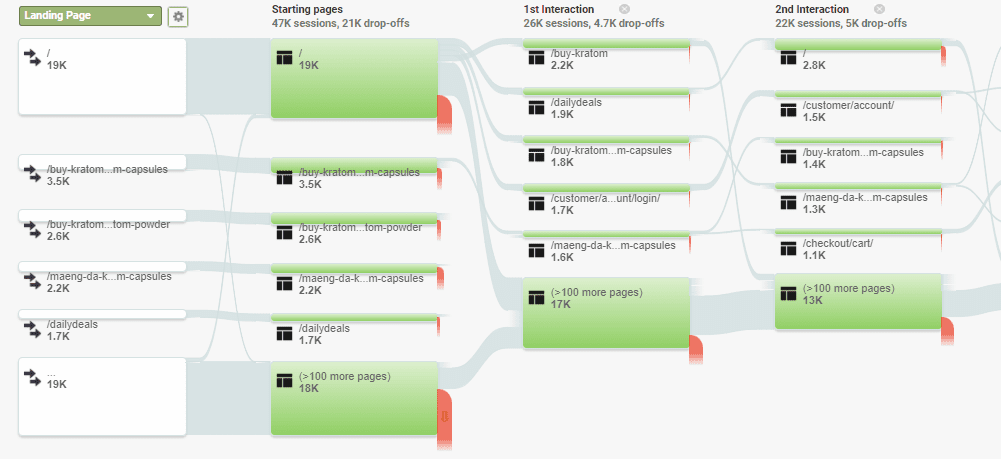As a business owner, you may find yourself looking for ways to improve your site for higher traffic and more conversions. You may be considering a site redesign. If you are, this article will help you. Here are some tips to help you start the website redesign process.
What is a Website Redesign Strategy?
The website redesign process updates and improves a site’s design and layout. This can be done for a variety of reasons, including increased functionality, security, accessibility, or simply to freshen up the site. Website redesigns can be done to any site that needs improvement, such as a blog, an online store, or an informational website.
Some essential components of the website redesign process include:
- Improving the functionality of the site by adding new features or making it easier to navigate the site
- Making the site more accessible by enhancing mobile-friendliness and adding alternative content formats such as audio and video
- Migrating data from one platform to another (e.g., from an old blog to a new blog) should be part of your website redesign strategy
- Improving security by implementing additional protocols or changing how information is stored on the server
Understanding an Effective Website Redesign Strategy
A website redesign process is often needed when the content of the site has changed, and the current layout is no longer functional. When a site is redesigned, the entire site may be changed, including the structure and layout of all pages. A redesign can also be a change in a single page or one section of a website. If only a portion of the website needs to be redesigned, this can be referred to as an update or refresh.
If your business has outgrown its current website and needs more functionality than is possible with your current design, consider hiring a web design agency so that you don’t have to take care of the process yourself. The costs will add up over time, and it may even take longer for an in-house team to complete.
Define the Process for Redesigning
First, you must define your goals for the website redesign process to meet the needs of the customer. This will help clarify what you want to achieve with the site. Next, you must determine if the site is just outdated or if it is no longer working properly. If it is simply outdated, you may only need a quick refresh rather than a full redesign. If it is not working properly or does not meet your goals, then you will likely need to do a full redesign.
Once you have determined what type of redesign you need, you can begin planning the essential steps in your website redesign strategy. These steps will depend on your goals and needs and the type of redesign you’ve decided upon. Finally, implement your plan and follow up on any changes or issues that may arise along the way.
Checking Your Business Goals & Understanding the Purpose for Redesigning
It’s important to take time to assess your goals and understand the purpose of your website redesign process. If you’re just looking for a new design to fix a few aesthetic problems, it might be a good idea to invest in a redesigning service. However, if you want to change the way your site displays information or make it more interactive, your website redesign strategy might be a more expensive and time-consuming project.
Things to Check on Your Website
A website redesign process can be daunting, but it’s an important part of website maintenance. If you’ve been neglecting your website for a while, or if you’re just starting out, here are some steps you’ll want to take to analyze your site before planning your website redesign strategy.
Check Google Analytics


Do you want to know what’s working on your site before you spend time and money redesigning it? Check Google Analytics.
Almost everything you do is based on data. You make decisions, create content, and design campaigns based on data. So why would you make a major decision like changing the design of your website without first checking your Google Analytics? Google Analytics tracks and reports website traffic, visitor behavior, and online sales for websites and will help you come up with the right website redesign strategy.
Google Analytics helps you to:
- See how many people visit your site each day or each month
- Find out what pages on your site are most popular
- See where your visitors are located
- Determine how long your customers stay on your site
- Find out what pages are giving you the most trouble
- Figure out which pages have the highest conversion rate

Understand How Many Visitors Are Affected By Your Site
When considering your website redesign process, it is important to put yourself in the shoes of your audience. Understanding the users who engage with your site is essential.
Based on Google Analytics, you can determine what parts of your site satisfy customers and which don’t. Using this information, you can assess how to improve your website to increase their satisfaction and remove components that cause poor user experience. Make sure to consider how design can be improved to enhance the customer experience.
What Difference Will The Redesign Make?
Planning your website redesign process is a great way to create a fresh, new look for your business. A redesign can help you better reach your target audience and engage with customers. It also helps you stay on top of new trends and technologies that may be relevant to your business.
A website redesign is an investment towards the future of your company. It gives you the opportunity to set yourself apart from competitors and attract new customers. A redesign can help you:
- Develop a stronger, more cohesive brand image
- Improve customer experience and conversion rates
- Stay up to date with changes in web design trends, technologies, and best practices
- Attract the right traffic
How to Tell if Your Website Needs Redesigning?
Almost 75% of customers judge your website’s credibility based on its design. It is important to plan your website redesign process when it is not functioning properly. If your website is not loading quickly or the design is outdated, then it may be time for a redesign. You can also redesign your website to make it more aesthetically pleasing or user-friendly.
Check the Design
Designing an attractive, functional website requires both skill and talent. There are different types of design styles, and each one has its own set of guidelines. The design process should be thought out carefully before changing anything. It’s important to know your desired aesthetics and the restrictions imposed by your platform before beginning to redesign.
A website redesign process can be difficult. It’s important to know the design style that is currently in use on the site and any changes you want to make, as well as understanding what type of audience it will be targeting. Redesigning a site without understanding these things can lead to a site that lacks appeal and may even be hard for visitors to navigate. A redesign also costs a lot of time and money, so you want to plan properly so that it will have the desired results.
Are Your Sales Being Impacted?
Have you noticed a decrease in sales without any changes to your marketing strategy? If so, it may be time to plan a new website redesign strategy. Everyone is online today, but what does that mean for your company? It means that the competition is online, too, and they are looking to steal your customers. If your website design lacks creativity or fails to advance your brand, they might succeed.
Are Users Complaining?
To avoid redesigning a website for the wrong reasons, it is important to identify any customer complaints when planning your website redesign process. If there are no complaints, then there is likely no need for a redesign. If there are complaints, however, these should be fully addressed by the redesign.
Side Effects of a Website Redesign Process

Over half of Google searches are conducted on mobile devices, so your website needs to be compatible with most devices. A website redesign process can make that happen; however, there could be certain side effects — some positive, and others negative. It all depends on the people who are using the website and whether or not it meets their needs.
One positive effect is that a redesign can advance new company promotions or product releases by delivering a more aesthetically pleasing site. The new site could potentially engage more customers if they’re attracted by the updated design. Another positive is that with redesigns, you will typically enjoy better site performance because it’s not bogged down with old code or outdated features.
A negative effect is that some existing customers might not like the new design and may choose to purchase from competitors. Certain design features may be particularly likely to alienate customers, such as featuring too many ads or pop-ups.
Optimizing Your Website
You know you need to optimize your website for search engines like Google, but where do you start? First, you need to start with keywords. What are the most important words that people are using when they search for your product or service? Research and identify the most important keywords and use them in the relevant pages on your website. Next, make sure you have a high-quality sitemap. This will allow search engines to easily find all of the pages on your website so they can index it. Finally, make sure your website is mobile-friendly so people can easily access it when they’re using smartphones or tablets.
Knowing The Impact It Will Have On Your Customers
When planning your website redesign process, you may be wondering how it will impact your customers. If you are looking for a boost in sales or to better engage with your audience, it is important to understand that the redesign will not happen overnight. It can take months for search engines to index the new site and show it in search results, but there are things you can do during this time to help your customers find you.
It is important to notify your customers of the changes. For instance, if you are changing hosting providers, email existing customers about the change and let them know what they should expect when they visit the new site. Include a link to the new site to make it easy to visit.
Be sure that any URL changes redirect properly so that visitors will not get lost if they go back to visit an old link. Emails should also be redirected so that people who subscribed through an old email address will receive future emails.
Things to Know Before Redesigning Your Website
Before you start your website redesign process, you should know a few things to make sure you design it in the best way.
- Keep it simple. Your website is not meant to showcase your design skills. It is meant to let people know about your business or product. Keep the website clean and uncluttered.
- Navigation is very important. Feature the main navigation bar at the top of the page so that people can find their way around easily.
- Be consistent with fonts, colors, and layouts to reflect your brand and allow visitors to navigate your site easily.
Check if You Need to Migrate Your Website
The easiest way to avoid migration is to design your website with future changes in mind. For example, utilize CSS to allow for easy layout changes without the need to update the HTML. If you’re still unsure about whether or not your website needs a migration, here are some basic steps to help you determine if it’s necessary:
- Check for dead links and outdated content
- What is the current state of your website? How was it built?
- Does your website use Flash?
- Does your site run on an old version of Joomla or WordPress?

What Will Redesigning Your Website Give You?
Redesigning your website will give you more time to work on other projects, greater flexibility, and a better experience for your readers. You will have more time to work on other projects because you won’t have to spend hours fixing errors on your website. You’ll have more flexibility because you can create a new site with modern web standards with fewer limits on what you can do. Finally, your readers will have a better experience because you’ll be using up-to-date technologies that are compliant with web standards.
Understanding What a Failed Redesigning Will Do To Your Business
A failed redesign can have a huge impact on your business. Customers and clients will question the credibility and reliability of your company. The design failed, so why should they trust you with their business? The redesign might also cause a decrease in sales or customers, which will affect the company’s bottom line.
This is why it’s important to ensure that the redesign is successful before you go ahead with it. You can’t afford to make mistakes that will cost your company money and respect.
Steps to Begin a Website Redesign Process
There are over 1.5 billion websites on the internet today. They are all fighting for the attention of a very limited customer base. This is where your website redesign strategy comes into the picture. Your website redesign process is not something to take lightly. It can be a daunting task, but with the right tools and guidance, it can be a lot more manageable. It is important to first define your desired website aesthetics. Once you’ve done that, it is time to find the best design software for your needs. This will not only make your job easier but also allow you to save time and money in the long run.
Using quality design software will help you import all of your existing content with ease, saving time and effort. When importing content from your old site into the new one, make sure to only copy necessary text. It is also important not to import unnecessary images or other files because they might cause issues later on during the process.
Then you can actually create your website! Once you have finished selecting all of the necessary features for your redesign project, it’s time to start building! You can either use a template or start from scratch. If you are using a template, be sure to edit any elements that are not appropriate for your desired vision before building out these pages so they match up with how you want them in the end. If starting from scratch, it’s best to sketch out all of the pages before adding any content to minimize mistakes during this stage. Following these steps and following them well will help make this process easier and less stressful!
Understanding the Steps for a Website Redesign Strategy
For a successful website redesign process, you need to create a plan for the changes that will be necessary. This includes making decisions about the appearance of the new design, as well as what content will be needed and how it will be organized.
Next, you should create an outline for the process itself. This includes setting deadlines and determining each stage of the project. It’s also helpful to map out each step to help you track the process over time.
The next step is determining how long the project will take and how much money will be needed throughout the project so that budgeting can take place accordingly. One helpful tip: many websites offer free templates for web pages, which can help save on design costs if desired.
How to Help Your Website Succeed
If you want to improve your site’s user experience, it’s important to explore the data. The first step is to analyze how your users are interacting with your site — what are they clicking on? What pageviews are high? What pages have high bounce rates? With this data in hand, you can better target what content to provide and where it should live on your site.
Increasing Website Traffic After a Redesign

After a company redesigns its website, it may initially see less traffic than before. This can be caused by many different factors, such as lower ranking in search engine results pages (SERPs). There are several things businesses can do to keep people on their site and increase traffic which includes:
- Add a blog to your site. Blogs are a great way to create high-quality content that will keep people on the site longer. It is also a great way to build an audience by delivering content that is relevant to them.
- Use social media sites such as Twitter and Facebook to communicate with your customers and get them excited about your company’s new design.
- Update your sitemap with the new URL so it is easier for search engines to find you.
What Makes a Good Website Design?
A good website should be pleasing to the eye and allow for easy navigation. The design should be intuitive, with clear features and links. A good website comes with a variety of tools, such as an RSS feed, search engine, and blog. They should also have a responsive layout that can be viewed on any type of device. A good website structure will allow the user to see the company’s products or services, contact information, and address.
Don’t Repeat Past Mistakes
It’s important to remember that every website is different and has different needs. What worked for one company may not be the best solution for your company. Just because the last designer you hired did a great job with your website doesn’t mean you should hire them again. You deserve better than a repeat of the same design and content you already have. Plan your website redesign process with fresh ideas in mind.
Align Your Business Goals with Your Website Design
One of the most common reasons for redesigning a website is that it needs to be more mobile-friendly. With so many people using their mobile devices to surf the web, it makes sense to have a site that is easy to navigate on smaller screens. You can also change fonts or colors or rearrange navigation buttons to make it feel more modern and up-to-date.
Another popular reason for redesigning a website is that there are too many pages, too many images, or too much content on the site. A redesign can help simplify things by combining pages or removing unnecessary content so that visitors can find what they are looking for more easily.
It’s also important to align your business goals with how you want visitors to interact with your site. If you are looking for ways to increase conversion rates, make sure the design of the site supports this goal by adding components like social media links, newsletter signups, and contact forms where they will be most useful and easy for visitors to find.
Optimize Your Website With BESTWEB
In today’s age of mobile-first, responsive web design, you need a website that looks good and works smoothly on all devices. It is important to plan your website redesign process effectively with the right research and blueprint. To learn more about what goes into a website redesign or any aspect of maintaining an outstanding business website, follow the BESTWEB blog for tips from the experts.

